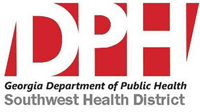Download Here
March 14, 2024
Albany, GA—Recent flooding has led to an urgent reminder from the Georgia Department of Public Health. Residents whose wells were affected by the flooding are urged to take immediate steps to disinfect their wells to ensure the safety of their drinking water.
Flooding in the area has raised concerns regarding potential contamination in private well water supplies. As a precautionary measure, the Georgia Department of Public Health recommends that residents with wells in flooded areas take the following steps designed by the EPA to safeguard their drinking water:
Step 1: Assessment of Well Condition
- Before initiating the disinfection process, inspect the well for any visible damage or exposed wiring. If damage is observed, seek professional assistance before proceeding with disinfection.
Step 2: Clearing Sediments - If the water appears muddy or cloudy, run water from an outside spigot with a hose attached until it runs clear and free of sediments.
Step 3: Bleach Pouring - Determine the appropriate method for pouring bleach into the well based on its type. Use a funnel if necessary and carefully pour a gallon of diluted bleach down into the well casing.
Step 4: Chlorine Detection - After adding bleach, run water from an outside hose into the well casing until the smell of chlorine is detected. Then, turn off the outside hose.
Step 5: Flushing Faucets - Turn on all cold water faucets, both inside and outside the house, until the chlorine odor is detected in each faucet. Then, shut them all off.
Step 6: Waiting Period - Wait 6 to 24 hours before turning the faucets back on. During this time, refrain from drinking, cooking, bathing, or washing with the water as it contains elevated chlorine levels.
Step 7: Chlorine Odor Removal - After the waiting period, run water from an outside spigot with a hose attached into a safe area until the chlorine odor dissipates.
Step 8: System Disinfection - With the absence of chlorine odor, the system should be disinfected and ready for use.
- Step 9: Post-Disinfection Testing
- Arrange to have the water tested for bacteria 7 to 10 days after disinfection to ensure its safety for consumption.
Residents with inquiries or requiring assistance regarding well disinfection procedures are encouraged to contact their local environmental health department or visit www.SWHealthDistrict.org for more information.
